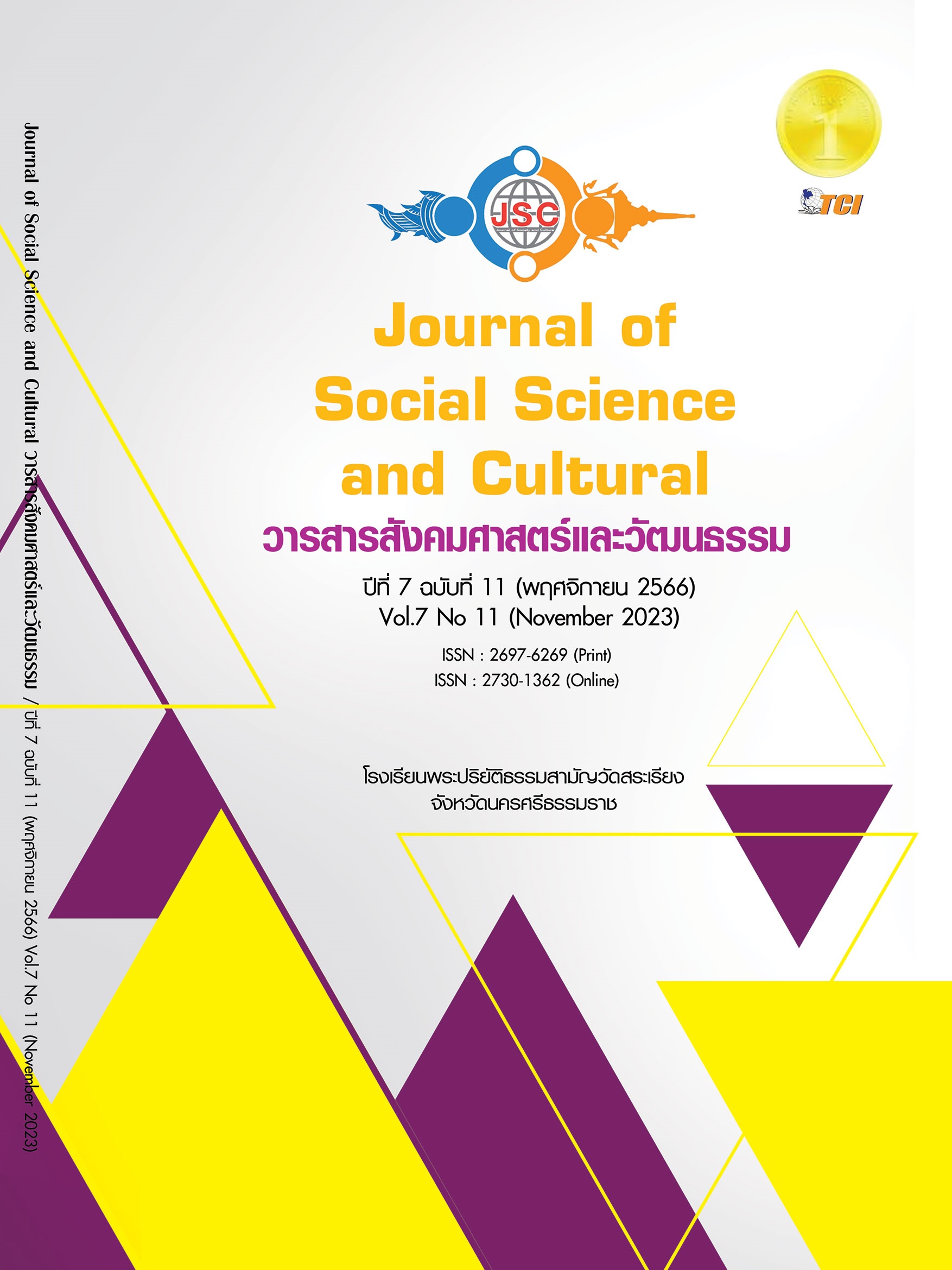COMPOSITION AND DEVELOPMENT OF INDICATORS OF CREATIVE PROBLEM SOLVING COMPONENTS FOR MATHAYOM 5 STUDENT, SARABURI WITTHAYAKHOM SCHOOL
Main Article Content
Abstract
The Study of component and indicators of creative problem solving components for grade 5 students. The purposes of this research were to: 1) Study the main components, sub-components and indicators of creative problem solving for grade 5 students, 2) To confirm the suitability of the main supporting components subcomponents and indicators of creative problem solving for grade 5 students using content analysis and confirmation of appropriateness by experts. The sample group consisted of 5 experts by purposive selection. Tools used include a scale to evaluate the appropriateness of the components and factors of creative problem solving. The researcher collected data from a total of 5 experts by using a suitability assessment form of an evaluation scale, data analysis used content analysis and finding the average and standard deviation. The results of the study were found: 1) The results of the study of the main components, sub-components and indicators creative problem solving for grade 5 students, it was found that there are 3 main components, consisting of 1) problem solving, 2) thinking, consisting of critical thinking. and creative thinking and 3) decision making, sub-components, 12 sub-components and has 18 indicators. 2) The results confirm the appropriateness of the main components, subcomponents and indicators of creative problem solving for grade 5 students by experts it was found that the total average was higher than the specified criteria is (X = 4.84, S.D.= 0.55) at the highest level. This means that all components and indicators are consistent and affect the develop creative problem solving for grade 5 students and have a step-by-step process that will encourage students to develop creative skills in behavior to confirm the suitability of the main supporting component, subcomponent and indicators of creative problem solving for grade 5 students, well how about content analysis and confirmation of suitability by experts.
Article Details
References
ทิศนา แขมมณี. (2560). 14 วิธีสอนสำหรับครูมืออาชีพ. (พิมพ์ครั้งที่ 13). กรุงเทพมหานคร: สำนักพิมพ์แห่งจุฬาลงกรณ์มหาวิทยาลัย.
ธัญญารัตน์ โกมลเกียรติ. (2557). ผลของการจัดกิจกรรมการเรียนรู้คณิตศาสตร์โดยใช้กระบวนการแก้ปัญหาเชิงสร้างสรรค์ที่มีต่อความสามารถในการแก้ปัญหาและความคิดสร้างสรรค์ทางคณิตศาสตร์ เรื่อง การประยุกต์ 1 สำหรับนักเรียนชั้นมัธยมศึกษาปีที่ 1. ใน วิทยานิพนธ์วิทยาศาสตรมหาบัณฑิต สาขาวิชาคณิตศาสตร์ศึกษา. มหาวิทยาลัยบูรพา.
นลินทิพย์ คชพงษ์ และวรรณี สุจจิตร์จูล. (2557). การศึกษาเอกลักษณ์ของนักศึกษาวิชาชีพครู คณะครุศาสตร์ มหาวิทยาลัยราชภัฏนครปฐม. ใน การประชุมวิชการระดับชาติ ครั้งที่ 7. สถาบันวิจัยและพัฒนา มหาวิทยาลัยราชภัฎนครปฐม.
พนม จองเฉลิมชัย. (2563). การพัฒนารูปแบบการจัดการเรียนรู้ ที่ส่งเสริมทักษะการแก้ปัญหาเชิงสร้างสรรค์สำหรับ นักศึกษาวิชาชีพครู. ใน ดุษฎีนิพนธ์ปรัชญาดุษฎีบัณฑิต สาขาวิชาวิทยาการทางการศึกษาและการจัดการเรียนรู้. มหาวิทยาลัยศรีนครินทรวิโรฒ.
พัชรา พุ่มพชาติ. (2552). การพัฒนารูปแบบการจัดประสบการณ์การแก้ปัญหาอย่างสร้างสรรค์สำหรับเด็กปฐมวัย. ใน ดุษฎีนิพนธ์ปรัชญาดุษฎีบัณฑิต สาขาวิชาหลักสูตรและการสอน. มหาวิทยาลัยศิลปากร.
รุสมีนี หะยียูโซ๊ะ. (2559). ผลของการจัดกิจกรรมการเรียนรู้คณิตศาสตร์โดยใช้กระบวนการแก้ปัญหาเชิงสร้างสรรค์ที่มีต่อความสามารถในการแก้ปัญหาและความคิดสร้างสรรค์ทางคณิตศาสตร์ของนักเรียนชั้นประถมศึกษาปีที่ 5 สังกัดสำนักงานเขตพื้นที่การศึกษาประถมศึกษานราธิวาส เขต 3. ใน วิทยานิพนธ์ศึกษาศาสตรมหาบัณฑิต สาขาวิชาหลักสูตรและการสอน. มหาวิทยาลัยสงขลานครินทร์ วิทยาเขตปัตตานี.
สำนักงานรับรองมาตรฐานและการประเมินคุณภาพการศึกษา (สทศ). (2563). การประเมินคุณภาพภายนอกรอบ 4 (ปี 2559-2563). กรุงเทพมหานคร: สำนักงานรับรองมาตรฐานและการประเมินคุณภาพการศึกษา (สทศ).
สิทธิพร ผกากลีบ. (2560). การพัฒนาตัวบ่งชี้คุณลักษณะอันพึงประสงค์ด้านการอยู่อย่างพอเพียงของนักเรียนระดับมัธยมศึกษาตอนปลาย. วารสารมนุษยศาสตร์และสังคมศาสตร์ มหาวิทยาลัยมหาสารคาม, 36(3), 140-150.
Isaksen, S. G. & Treffinger, D. J. (2004). Celebrating50 years ofReflective Practice: Versionsof Creative Problem Solving. Retrieved October 5, 2009, from http://cpsb.com
Osborn, A. F. & Parnes, S. J. (1966). The Osborn-Parnes Creative Problem Solving Procedure. Munich: GRIN Verlag.
Torrance, E. P. (1965). Rewarding creative behavior: Experiments in classroom creativity. Englewood Cliffs, N.J: Prentice-Hall Inc.
World Economic Forum. (2018). The Future of Jobs Report. Retrieved October 5, 2022, from http://www3.weforum.org/docs/WEF_Future_of_Jobs_2018.pdf


